#larch valley
Explore tagged Tumblr posts
Text









A trek to Larch Valley in Banff National Park.
I was a little tight on time to get up there and back to the bus, but it was a beautiful peaceful sanctuary up there amongst those cloudy peaks. A difficult hike but I am glad I did it.
11 notes
·
View notes
Text


" Autumn in Albania " // © Giulio Gröbert
#Tamarë#Albania#nature#landscape#Autumn#Fall#Valley#Mountain#River#Larches#Trees#Forest#Cabin#photography#aesthetics#wanderlust#explore#follow#discover
763 notes
·
View notes
Text
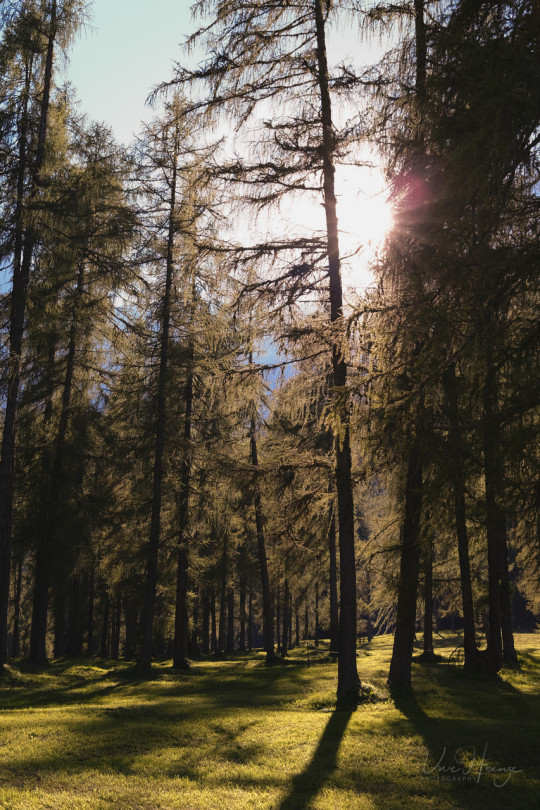
larches in the evening light . . . | uwhe-arts
#larches in the evening light#photographers on tumblr#larches#trees#nature#uwhe-arts#original photographers#original creators#uwhearts#fischlein valley#explore#south tyrol#vertical#photography#landscape#backlight#sunrays#sunset#evening mood#x100v#fujifilm x100v#long shadows
330 notes
·
View notes
Text

Larch Mirror At The Morteratsch Valley, Engadin
Swiss Landscapes in Autumn
By Vincent Croce

Golden Larches Of Engadin
#vincent croce#photographer#switzerland#landscapes#autumn#larch#fall colors#morteratsch valley#engadin#lake#nature#forest#trees
14 notes
·
View notes
Text
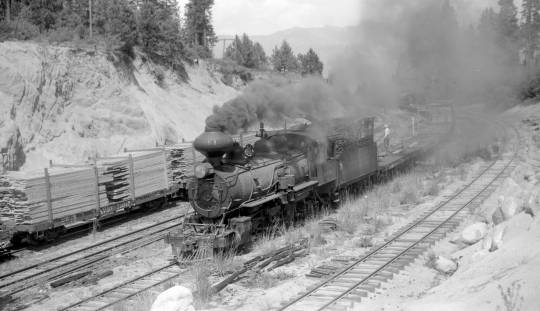
Sumpter Valley narrow gauge train, engine number 18, engine type 2-8-2 Westbound freight train. Photographed: Larch, Ore., July 28, 1938.
37 notes
·
View notes
Text
okay clangen fanfic time let’s go babey home run babey lets go!!!!
Chapter 1 - The Messengers
It was night over the valley.
The remnants of daylight pooled around the horizon, where the trees of Dappleclan cut into the thick, blue sky. The low clouds of greenleaf were long gone, leaving the stars stark and glittering.
Moorheart had almost finished the evening patrol. He’d sent the others home early when they’d complained of sore paws.
It wasn’t their fault. There weren’t enough warriors to go around nowadays.
He shook out his fur, taking extra care as he picked through the thistle-ridden paths of his clan’s territory. The trees hung low, drumming peacefully as he scraped under their lowest branches. He counted his steps as he went.
In leaf-fall the undergrowth was always so alive. Somewhere far beyond his sight he could hear the hum of busy insects and the babble of the distant stream - and beyond that, small creatures, feeding and nesting and chattering. He pressed his tongue to the roof of his mouth, ignoring the growl of his stomach.
It was the type of night that felt electric, sending his fur bristling and his whiskers to points. Part of him liked having it all to himself.
He took a left turn at the next marker, leaping up the body of a larch and letting the ground drop farther and farther below him. It was the type of night for climbing.
He used to linger in trees as an apprentice, to the point that his mother would joke about her son ‘with his head in the clouds’.
“You’re more squirrel than cat - bushy-tailed, and fascinated by heights.”
Something about it grounded him. The higher he climbed, the more the noise and the pain and the fear softened, as if muffled by the clouds or the slow, dark crush of nightfall. It was a kind of peacefulness only he seemed to understand.
Not that anyone else tried to understand. Not that anyone else got it.
It was clearer up here, where the breeze bit his ears to numbness and the earth trembled beneath him. Where the sky was so dark and so large he could look up and feel himself fall.
His fur prickled.
A storm’s brewing.
He was shaken from his musings when he heard movement below, of something picking its way through the undergrowth.
Dropping to a lower branch he stooped to take a look. A small ways off bushes rustled, parting to reveal a lithe shadow.
A rabbit?
Moorheart lowered his head as it crept closer.
No. Larger.
His ears twitched.
Cats.
He couldn’t recognise them from afar. And he didn’t like how they came from downwind.
The camp wasn’t far, though to flee he’d have to reach ground, and he doubted he could drop quietly enough to avoid alerting his new companions.
He could call for help, but how long would it take for his clanmates to arrive? Certainly long enough for an assailant to scale his larch and sink their teeth into him.
Moorheart tugged his nervous claws from the bark beneath him.
Focus. This is hardly an invasion.
The cats were closer now, and Moorheart could see the way they moved, ears pricked and tails swaying. They walked with sure-footed grace, lightly dodging the brambles and boughs of his clan’s territory- Rainclan, he thought to himself, frowning.
They were alert, they were cautious, but they weren’t stealthy.
Moorheart raised his head.
“Who's there?”
“Moorheart? Is that you?” a familiar voice called.
“Milkfur? What is this?”
“We have a message for Volestar.”
“This couldn’t wait until morning?”
“Where’s your patrol?” she called.
He paused. Milkfur’s ear twitched. He couldn’t read her face from this distance.
“No patrol,” he said. “It’s just me out here.”
“Come down.”
Moorheart did, leaping deftly from bough to bough and only half-stumbling on his landing. Closer now, he saw the faces that made up this delegation: Milkfur, a golden molly with long whiskers and a round face; Crowpelt, a plump young tom with glossy fur; and Brightleg, a cat with cold, grey eyes that made him feel like leafbare was settling on his shoulders.
Moorheart wasn’t sure why a message would require three seasoned envoys; he felt somewhat like a pinned bird when they settled around him.
“Out with it, then,” he said, tail flicking. “What’s so important that it couldn’t wait ‘til dawn?”
Milkfur exchanged a look with Crowpelt.
“We found a body by the Thunderpath,” she said, quietly. “We… we think it's Rotstar.”
Somewhere far away, a bird whooped.
“What?”
“We think,” Milkfur repeated. “It’s difficult to tell. We thought we ought to get someone from Dappleclan out to check, just in case.”
“Maybe Volestar?” Crowpelt chimed. “Or Batpounce?”
"Yeah." Moorheart didn't know why, but suddenly his feet felt very heavy. "I’ll... I’ll fetch them.”
“Not tonight,” Brightleg said. “In the morning.”
“Right.” Moorheart met his gaze and shivered. In daylight.
“We just thought we should warn you, in case an apprentice stumbled upon it or- or something,” Milkfur said, as if sensing the chill in the air.
“Thank you.” Moorheart dipped his head. “Really.”
“I…” the golden molly shuffled where she sat, eyes fixed on the ground. “I’m sorry for your loss.”
Moorheart’s ear flicked.
“Thank you,” he said, terser. “I’ll send Volestar to the border tomorrow, at Sunhigh.”
Milkfur nodded; out of agreement or courtesy, he couldn’t tell. Then all three cats were gone in the shrubbery, light and quick as they arrived.
Moorheart watched them go, then took an angry tongue over his fur.
Far be it for a dead cat to get under my skin. I must be mad.
He turned, pushing thoughts of his former leader and her rotten ways from his mind. He would check the markers along the edges of the grove, wander up the hill to inspect the abandoned setts, then amble back to camp and curl into his warm nest, safe and sound.
This will all blow over soon.
Somewhere far away, thunder growled.
#clangen#writing#real talk I haven’t written anything in years and I’m a bit sofucking scared of posting this#but nothing ventured nothing gained etc etc#this needs a name
78 notes
·
View notes
Text
Excerpt from this story from Grist:
n northwestern Montana’s Swan Valley, a pile of about 100 small logs, 10 feet long or so, sits neatly stacked, ringed by berry bushes, a few white wildflowers, and towering larch trees. Surrounding the logs are several acres of U.S. Forest Service land, which was thinned of dead, downed, and dense understory trees last year to reduce wildfire risk. The log pile that remains is too small to be processed into lumber, plus the sawmill just down the highway recently closed. So the wood may get sent to a pulp mill, if the price is right. Or it may sit in the forest for years. Smaller limbs may be burned in a prescribed fire. But Ning Zeng, a climate scientist at the University of Maryland, is sizing up the pile, too. He sees another solution: burying the logs, and all the planet-heating gases they’d otherwise release, underground.
That’s the idea of a carbon sequestration technique called wood vaulting. Forests throughout much of the western U.S. are overgrown, full of tangled trees and brush that’s primed to burn. The Forest Service’s wildfire crisis strategy calls for removing excess vegetation on up to 50 million more acres of federal, state, tribal, and private lands by 2032. Scientists and climate tech companies alike say wood vaulting could help store some of the carbon dioxide equivalent, in the form of flammable vegetation, that the Forest Service must deal with in the coming years — an estimated 2.2 billion metric tons. That’s roughly as much CO2 as cement production worldwide emitted in 2016, and as much as forests globally removed from the atmosphere last year.
“There’s more wood in the forest than markets for it to go,” said research forester Nate Anderson, who studies product supply chains for the Forest Service’s Rocky Mountain Research Station in Missoula. Valuing the carbon stored in wood vaults could change that.
5 notes
·
View notes
Text

Portrait/Token + Character Sheet commission I made for one of my players from the Princes of the Apocalypse campaign I'm currently running!
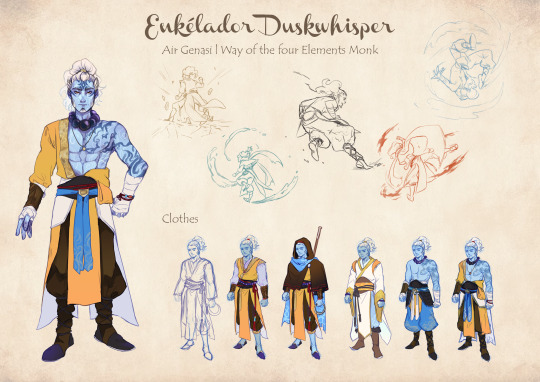
Enkélador Duskwhisper
Air genasi | Way of the four Elements Monk Enkélador is an Air Genasi found and raised at the Yellow Rose Monastery, he grew spending time between martial art training, meditation, and study of history and geography of the Faerûn. As others companions from the Monastery he got the mission to investigate some unnatural climatic changes along the Sword Coast, specifically in the Dessarin Valley. Monks can't stick together for this mission, instead, arrived at Red Larch he met an interesting trio from Waterdeep!
#d&d oc#d&d commission#air genasi#d&d monk#monk way of the four elements#princes of the apocalypse#rpg oc#commissions open
7 notes
·
View notes
Text

youtube
Epic Down will make you drag your knuckles down their hallowed halls of doom. Moving slowly under the crushing weight of time. Carving it’s path through the valleys of history and into a grim and desolate future.
18 notes
·
View notes
Text
Good lord. I’ve done a whole longer hike before getting finished with the writing for this one. The goal for this week then is to finish writing about this trip and the next one before the big end-of-summer trip that this is all training for.
Hiking Journal: Waterton Lakes NP,
Bauerman/Blakiston Valleys Loop Part IV, July 25
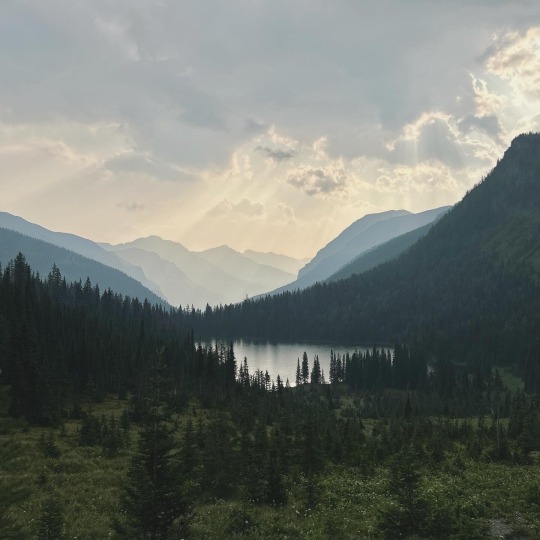
The start of the last day was amazing. It was mostly downhill but first we had to climb a couple hundred metres over the Bauerman Divide. Riding above Twin Lakes while the sun was still low on this morning when (finally!) snatches of cloud were drifting in, I mean, just look at it.
And appreciate the silhouette of this larch. I love a good larch.
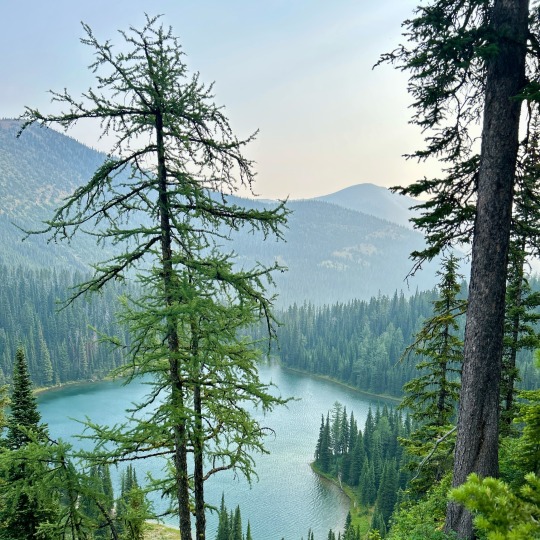
Descending into Blackiston Valley, though, we re-entered the Kenow Burn looking worse than I’d yet seen it. Maybe it’d burned again more recently. Nothing grew here, nothing lived here, and everything blackened fingers to the touch. No leaves rustled or needles swished; the only sound was the whistle of wind through stark black spars.
It was hard not to sink into climatic despair and unhelpful anger hiking through this section. A descent into Mordor, as the downhill seemed, called to mind the immutable power of latter-day Saurons.
But the lower valley proved the wisdom of hope by showing the power of succession. I think it was indeed a less recent burn down there, because here the reseeded chest-high lodgepole pines grew thick as grass.
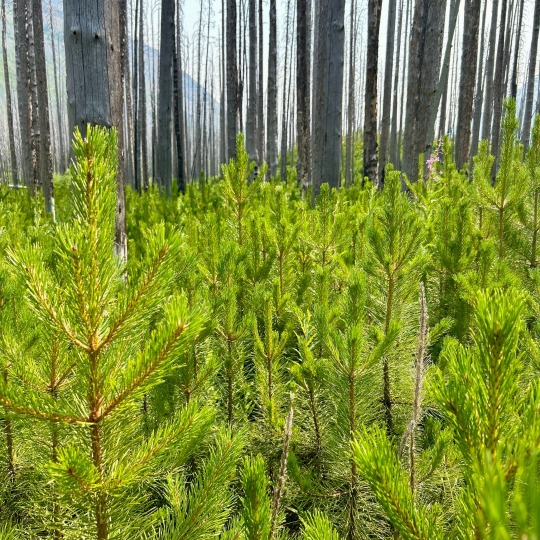
Lower Blackiston Creek flows over very pretty steps of red argillite.
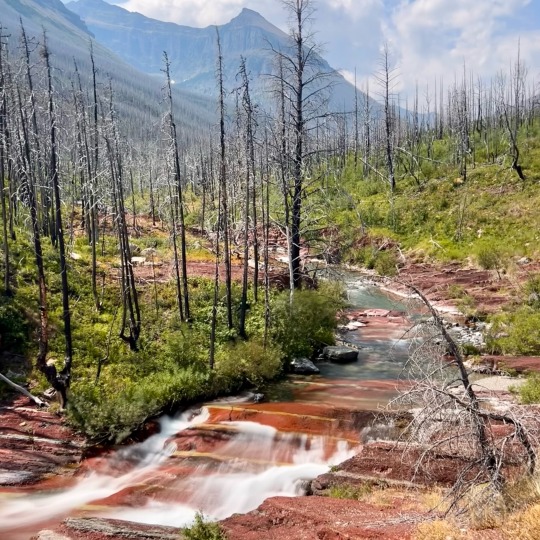
Lower still, it was a bit of culture shock coming from the backcountry into the busy tourist trail to the steel balconies, moulded all over into the beaver crest of Parks Canada, of the very developed Blackiston Falls overlook. People are walking in crocs? Where are their 30-pound packs? Is this allowed?
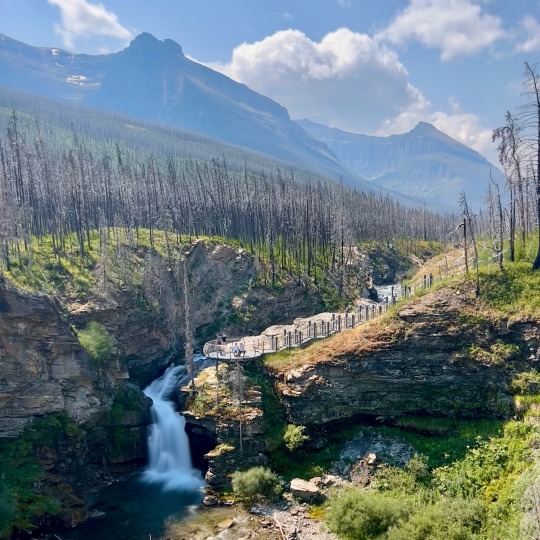
We got out before lunch somehow and went to get hot dogs in Waterton town. Finally, though I don’t have a very good photo of it, on the way out of the park we came across an example of succession and reclamation I never expected to see. In the prairie portion of the Park, they maintain a wide enclosed paddock of natural grassland, and within that area, a small herd of bison roam in if not the number then seemingly much the way that they would have two hundred years ago, before genocide-driving colonial hunting ended their reign as makers and kings of the continental interior. This is a bit of what Niitsitapi must have looked like for untold ages long before my time.
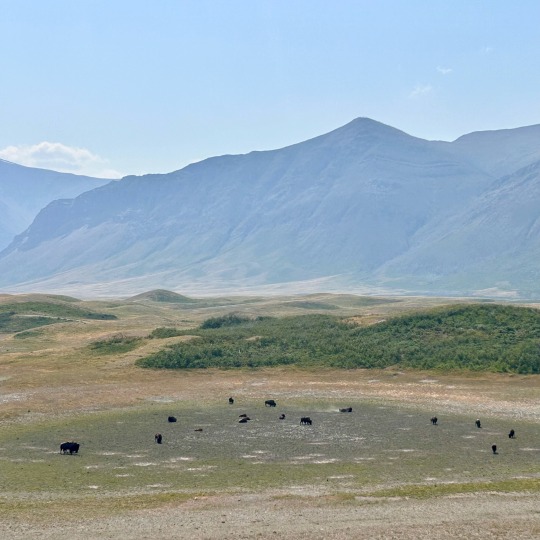
In sum total, four days, three nights camping, ~50 km, and almost 1900 m climbed vertically. Lessons from the trail: nature renews. We can help.
#my photos#mountains#hiking#canadian rockies#alberta#Waterton lakes national park#waterton#adventurecore
2 notes
·
View notes
Text


Up in the mountains, living my best life. (But still so very tired)
2 notes
·
View notes
Text
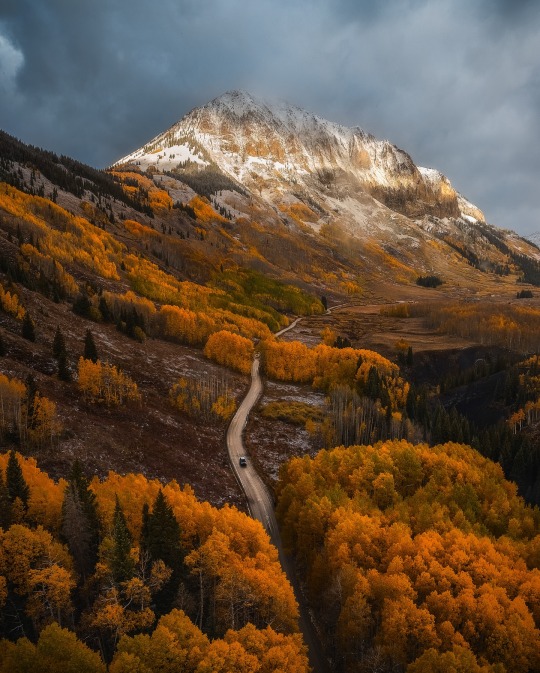
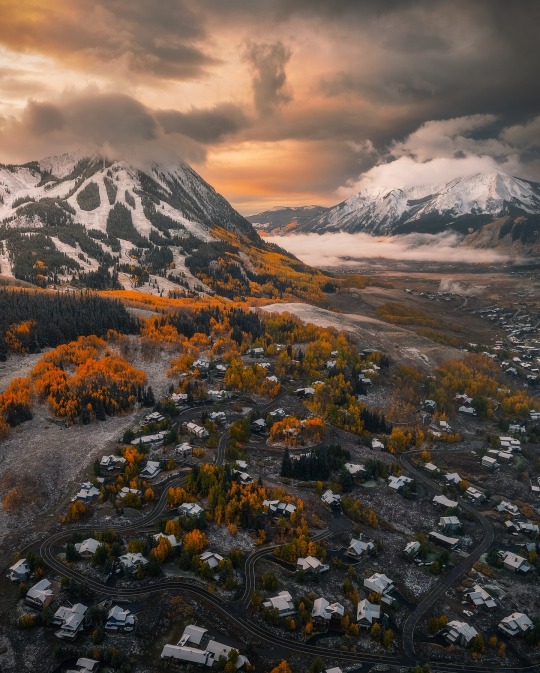

" Seasons clash 🍂❄️" // © Austin Pedersen
#Crested Butte#Colorado#United States#nature#landscape#Autumn#Fall#Winter#Mountains#Forest#Trees#Larches#Cabin#Valley#Snow#Clouds#Dark#Moody#photography#aesthetics#wanderlust#explore#follow#discover
468 notes
·
View notes
Photo

Larch Valley in the Canadian Rockies [3872 x 2178]
10 notes
·
View notes
Text
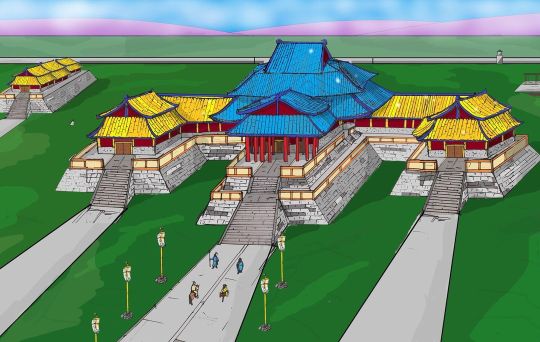
THE GREAT KHAN'S PALACE AT QARAQORUM
In Qaraqorum, the Mongol Imperial capital from the 1230s-60s, the Great Khan held his residence twice a year. First built by Ögedei Khan, and refurbished by Möngke, it was in a "Forbidden city," to the south of the main city of Qaraqorum, a separate, walled-off section which had numerous secondary structures and palaces for other members of the Altan Urag and their servants. The structure was known was the Qarshi to the Mongols (palace) and also by a Chinese name given to it, the Wanangong, Palace of Eternal Peace.

The Qarshi of Qaraqorum/Erdene Zuu monastery is the sqaure at the bottom of this topopgraphic map of the site
While the Qarshi is no longer extant, we have a fairly good understanding of its position and layout thanks to the numerous references and descriptions of it in Chinese, European and Islamic accounts, and comparisons to the sites of other 13th century Chinggisid palaces (like Kondui palace).
The Qarshi consisted of a central, main hall (often singled out in sources for its magnificence and height), flanked by two smaller halls ("naves", in William of Rubruck's eye-witness description, who compared the entire structure to a church). It was built by Chinese craftsmen and this layout matches certain Chinese palace designs, though modified for Chinggisid tastes. In the Orkhon Valley, Siberian larch along with local granite quarries were use in the city, and must have featured extensively on the palace. Labourers were brought in to make dried-bricks and kilns for roof tiles on-site for most of the rest of the construction.
With the abandonment of the city by the fifteenth century, the Qarshi fell into disrepair. By the late 1500s, the Erdene Zuu monastery, was constructed on the site of the palace, likely reusing what remained of usable building material. While Erdene Zuu differs in layout, it likely offers a clue to the orientation of the earlier structure
You can learn more about Qaraqorum's role in Mongolia's production networks in my latest video on nomadic blacksmithing:
youtube
9 notes
·
View notes
Note
So, I see that both of you have names differing from your Spirit titles. Do you know any other names of the other Spirits of the six Spirit-inhabited realms?
Wait, does Eden count as realm seven...?

Slumbering Shipwright: I knew everybody in my community…Leppi, Rhop, Riodin, Nymph, Lyca, and Hesper.
Slumbering Shipwright: I also knew Cirrus and Stratus from Isle, and Hesper’s cousin Blanc from Forest.

Pouty Porter: I’m in the same boat mostly…Larch, Hazel the first AND Hazel the second, Hickory, Maple, Acacia, Hawthorn too I guess (not that we ever talked much)…and…Willow (sigh)…poor Willow…
Pouty Porter: As for people outside my home realm, I knew Fitz and Nevis, those two siblings from Valley…there was this recruit in Oasis named Monte I talked with, real sweet fella…oh and Natha from Vault (show off).
Pouty Porter: And to answer your last question, Eden does count. We don’t call it the Kingdom of the Seven Realms for nothing…but I never knew anybody from Eden.
Slumbering Shipwright: Me neither…
#ask the ancestors#ancestor april#thatskygame#sky children of the light#sky: children of the light#image post
8 notes
·
View notes